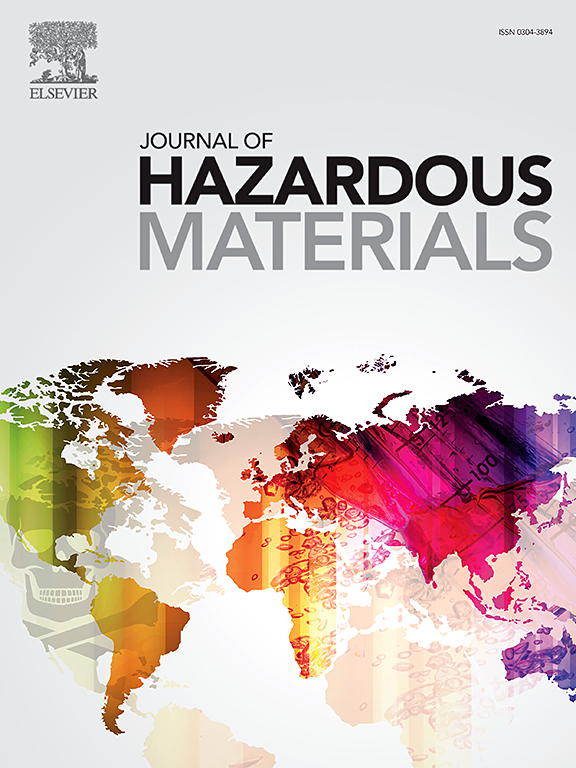脱氧雪腐烯醇通过激活氧化应激和干扰神经递质释放触发小鼠海马神经元焦亡
IF 11.3
1区 环境科学与生态学
Q1 ENGINEERING, ENVIRONMENTAL
引用次数: 0
摘要
脱氧雪腐镰刀菌醇(DON)是一种普遍存在的天然污染物,具有高毒性,影响多器官,可穿透血脑屏障,诱发神经毒性,威胁食品安全。在这项研究中,我们通过体内和体外模型研究了DON对海马神经元损伤的影响,以评估其潜在风险。结果表明,亚慢性DON暴露(细胞内500 ng/mL和1 mg/kg)。bw小鼠)增加过量ROS产生,激活NF-κB通路,上调NLRP3和ASC表达水平。因此,这触发Caspase-1激活,释放IL-1β和IL-18,从而诱导焦亡并引起海马神经元结构损伤。此外,DON暴露明显破坏细胞周期进程,干扰体内和体外几种神经递质的合成和释放。疾病与代谢物的相关性分析表明,DON暴露引起的神经递质差异改变与阿尔茨海默病有很强的相关性。疾病与代谢物的相关性分析表明,DON暴露引起的神经递质差异改变与阿尔茨海默病显著相关。综上所述,亚慢性暴露于DON通过激活氧化应激和干扰神经递质合成引发细胞焦亡,导致海马神经元的丢失和损伤。这项研究为DON暴露与海马免疫炎症之间的关系提供了新的见解。本文章由计算机程序翻译,如有差异,请以英文原文为准。

Deoxynivalenol triggers pyroptosis in mouse hippocampal neurons by activating oxidative stress and interfering with neurotransmitter release
As a prevalent natural pollutant, deoxynivalenol (DON) exhibits high toxicity, affects multiple organs, can penetrate the blood-brain barrier and induce neurotoxicity, thereby threatening food safety. In this study, we investigated the effects of DON on hippocampal neuronal injuries using both in vivo and in vitro models to evaluate its potential risks. Results showed that subchronic exposure of DON exposure (500 ng/mL in cells and 1 mg/kg.bw in mice) increased excessive ROS production, activated the NF-κB pathway, and upregulated NLRP3 and ASC expression levels. Consequently, this triggered Caspase-1 activation, released IL-1β and IL-18, thereby inducing pyroptosis and causing structural damage in hippocampal neurons. Furthermore, DON exposure markedly disrupted cell cycle progression and interfered with the synthesis and release of several neurotransmitters in vivo and in vitro. Correlation analysis between diseases and metabolites indicated that the differential altered neurotransmitters induced by DON exposure exhibited a strong association with Alzheimer's disease. Correlation analysis between diseases and metabolites indicated that the differentially altered neurotransmitters induced by DON exposure were significantly associated with Alzheimer's disease. In conclusion, subchronic exposure to DON triggered pyroptosis in cells through the activation of oxidative stress and interference with neurotransmitter synthesis, resulting in the loss and damage of hippocampal neurons. This research offers novel insights into the relationship between DON exposure and hippocampal immune inflammation.
求助全文
通过发布文献求助,成功后即可免费获取论文全文。
去求助
来源期刊

Journal of Hazardous Materials
工程技术-工程:环境
CiteScore
25.40
自引率
5.90%
发文量
3059
审稿时长
58 days
期刊介绍:
The Journal of Hazardous Materials serves as a global platform for promoting cutting-edge research in the field of Environmental Science and Engineering. Our publication features a wide range of articles, including full-length research papers, review articles, and perspectives, with the aim of enhancing our understanding of the dangers and risks associated with various materials concerning public health and the environment. It is important to note that the term "environmental contaminants" refers specifically to substances that pose hazardous effects through contamination, while excluding those that do not have such impacts on the environment or human health. Moreover, we emphasize the distinction between wastes and hazardous materials in order to provide further clarity on the scope of the journal. We have a keen interest in exploring specific compounds and microbial agents that have adverse effects on the environment.
 求助内容:
求助内容: 应助结果提醒方式:
应助结果提醒方式:


